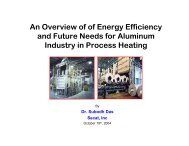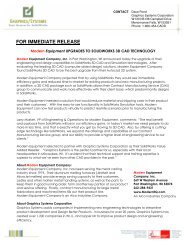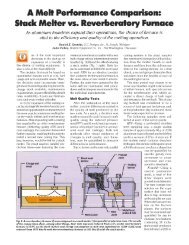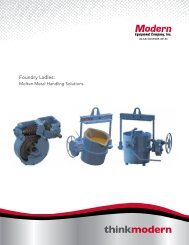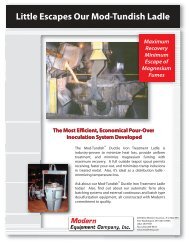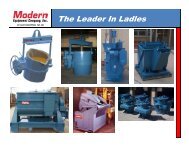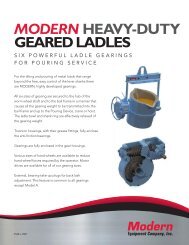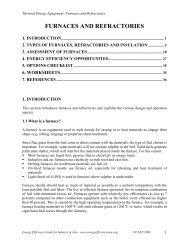ITP Metal Casting: Advanced Melting Technologies: Energy Saving ...
ITP Metal Casting: Advanced Melting Technologies: Energy Saving ...
ITP Metal Casting: Advanced Melting Technologies: Energy Saving ...
Create successful ePaper yourself
Turn your PDF publications into a flip-book with our unique Google optimized e-Paper software.
4.1.4 Immersion Heaters (Low-Temperature <strong>Melting</strong>)<br />
Immersion furnaces or heaters are currently used<br />
for low-temperature melting of zinc. The heat is<br />
generated by combustion or electrical resistance<br />
inside a tube submerged in molten material (Exhibit<br />
13). The heat is efficiently transmitted to the molten<br />
material through the wall of the tube by conduction.<br />
Combustion gases are never exposed to the molten<br />
metal, reducing oxidation losses and enhancing heat<br />
transfer to the molten metal. 23 The efficiency of a<br />
zinc immersion furnace is high at 63 to 67% 24 and<br />
provides melting rates of up to 1,600 lbs/hr.<br />
Immersion heat tubes are typically made of metallic<br />
materials that have high thermal conductivity and<br />
are coated with ceramic or cement materials to<br />
resist corrosive attack by the molten metal. When<br />
melting aluminum or other higher-temperature-<br />
Source: <strong>Metal</strong>s Processing Advisor<br />
www.energysolutionscenter.org<br />
Exhibit 13: Immersion heater<br />
melting materials, heavier ceramic coatings are applied because these molten materials act more<br />
aggressively on the tubes. The ceramic coatings, however, act as a thermal barrier and lower the<br />
productivity of the immersion heater. The mechanical demands on ceramic-coated metallic tubes<br />
are also very high. These tubes must be structurally strong to survive in an industrial<br />
environment and must be able to operate under frequent thermal cycling. A small crack in the<br />
coating can lead to rapid destruction of the tube and lost productivity. Higher-temperature<br />
melting furnaces utilizing immersion tubes are still considered experimental, and efforts have<br />
been made to develop more robust and protective tubes (see section 4.2.2).<br />
4.1.5 Induction Furnaces<br />
Induction furnaces have increased in capacity to where modern high-power-density induction<br />
furnaces are competing successfully with cupola melting (Exhibit 14). There are fewer chemical<br />
reactions to manage in induction furnaces than in cupola furnaces, making it easier to achieve<br />
melt composition. However, induction melting is more sensitive to quality of charge materials<br />
when compared to cupola or electric arc furnace, limiting the types of scrap that can be melted.<br />
The inherent induction stirring provides excellent metal homogeneity. Induction melting<br />
produces a fraction of the fumes that result from melting in an electric arc furnace (heavy metal<br />
fumes and particulate emissions) or cupola (wide range of undesirable gaseous and particulate<br />
emissions as a result of the less restrictive charge materials). 25<br />
15



